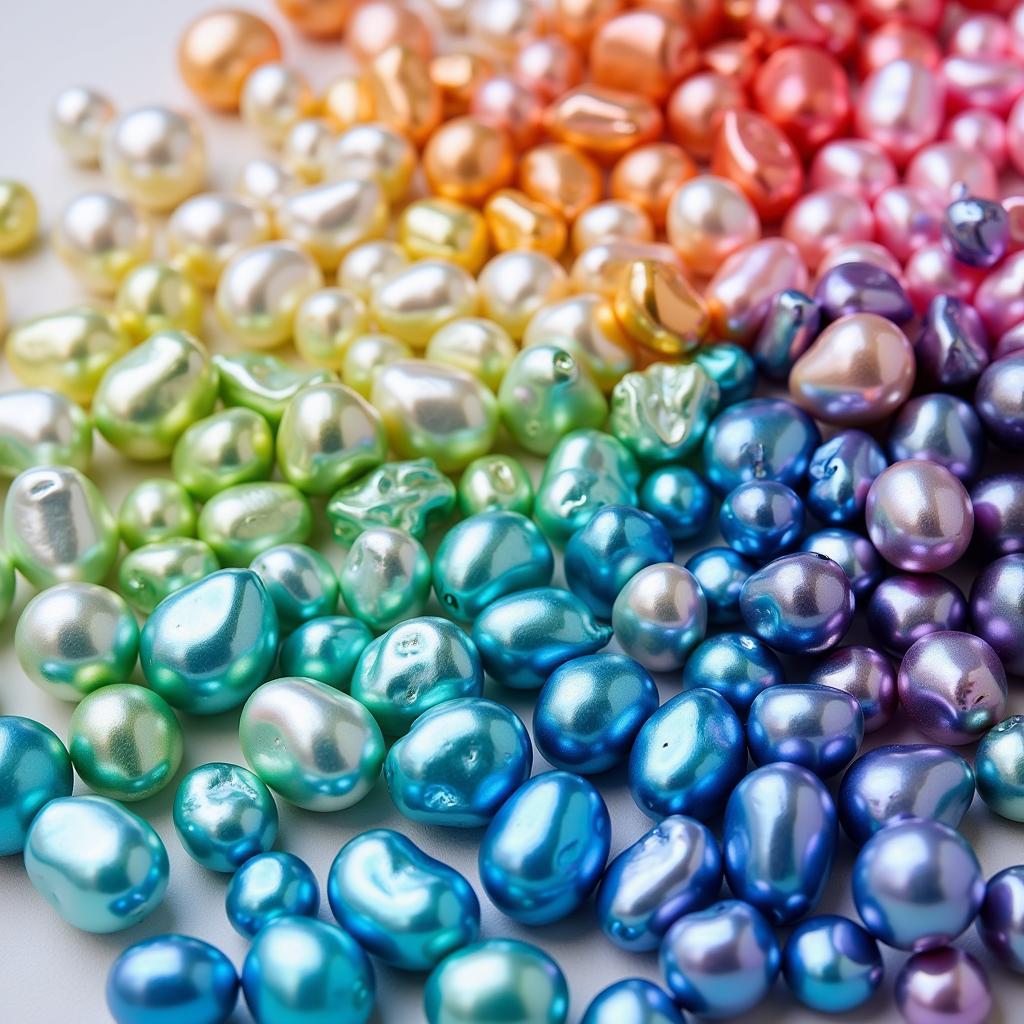The mesmerizing allure of pearls often lies in their captivating colors. But what determines a pearl’s color? It’s a fascinating interplay of factors, from the type of mollusk to the environment it inhabits, that dictates the final hue of these iridescent gems. Let’s delve into the science and secrets behind pearl coloration.
The Mollusk’s Mantle: The Foundation of Color
The primary factor influencing a pearl’s color is the mollusk itself, specifically the mantle tissue. This tissue secretes nacre, the iridescent material that forms the pearl. The mantle’s pigments and trace elements directly influence the nacre’s color. For example, silver-lipped oysters often produce pearls with a cool, silvery sheen, while black-lipped oysters are known for their dramatic dark pearls.
Pigments and Trace Elements: The Building Blocks of Hue
Pigments like porphyrins contribute to the pink, purple, and black overtones often seen in pearls. Trace elements like manganese can create hues ranging from yellow to brown, while copper can contribute to pink or reddish tints. These subtle variations in the mollusk’s mantle create the incredible spectrum of pearl colors found in nature. Want to know what colors pearls can be naturally? what colors can pearls be naturally
Environmental Influences: Nurturing Nature’s Palette
While the mollusk’s mantle lays the foundation for color, the surrounding environment also plays a significant role. Water temperature, salinity, and the availability of nutrients can all affect the nacre’s composition and, consequently, the pearl’s color. For instance, pearls cultivated in warmer waters may exhibit richer, more intense colors.
Water Quality: A Subtle Brushstroke
Even subtle changes in water quality can influence pearl coloration. Higher concentrations of certain minerals or organic matter can introduce unique tints and overtones. This delicate interplay between the mollusk and its environment underscores the natural artistry of pearl formation. Have you ever wondered what color a clam is? It might surprise you! what color is a clam
 Environmental Impact on Pearl Color
Environmental Impact on Pearl Color
How Does a Pearl Get Its Color? A Step-by-Step Process
- Nacre Secretion: The mollusk’s mantle secretes nacre, layer upon layer, around an irritant.
- Pigment Deposition: Pigments present in the mantle tissue are incorporated into the nacre.
- Trace Element Integration: Trace elements present in the mollusk and its environment are also integrated into the nacre.
- Light Interaction: The intricate layering of nacre and its unique composition cause light to diffract and reflect, creating the pearl’s iridescent sheen and color.
Do pearls come in different colors naturally? do pearls come in different colors naturally Yes, they absolutely do! The natural world provides an astounding range of pearl colors, proving the artistry of nature.
Expert Insight: Maria Sanchez, Gemologist
“The beauty of a pearl lies in its unique story, told through its color and luster. Each pearl is a testament to the intricate relationship between the mollusk and its environment.”
 Pearl Color Spectrum and Diversity
Pearl Color Spectrum and Diversity
The Magic of Overtones: Adding Depth and Complexity
Overtones, the subtle secondary colors that shimmer across a pearl’s surface, further enhance their visual appeal. These delicate hues, often seen as a soft blush of color over the base color, add depth and complexity. They are influenced by the same factors that determine the base color: the mollusk’s mantle, pigments, trace elements, and the surrounding environment. Have you ever wondered about the color of a snowflake? It’s more complex than you might think! what color is a snowflake
Expert Insight: Dr. James Chen, Marine Biologist
“Overtones are like nature’s brushstrokes, adding a final touch of artistry to each individual pearl. They are a testament to the complex interplay of factors that create these beautiful gems.” Curious about birthstone colors? You can find out more here: what is the birthstone color
Conclusion: A Symphony of Color
What determines a pearl’s color is a delicate balance of nature’s artistry. From the mollusk’s mantle to the surrounding environment, a variety of factors contribute to the breathtaking array of colors found in these iridescent treasures. Understanding these factors allows us to appreciate the unique beauty of each individual pearl.
FAQ
- What is the rarest pearl color? Blue and green pearls are considered among the rarest.
- Are all pearl colors natural? While many pearl colors occur naturally, some pearls are treated to enhance or change their color.
- Do different types of mollusks produce different pearl colors? Yes, different species of mollusks are known to produce pearls with distinct color characteristics.
- Can environmental factors change a pearl’s color over time? Prolonged exposure to harsh chemicals or extreme temperatures can potentially affect a pearl’s color.
- How can I tell if a pearl’s color is natural? A gemologist can determine if a pearl’s color has been treated.
Common Scenarios and Questions
-
Scenario: A customer is looking for a specific pearl color to match a particular outfit.
-
Question: What factors should I consider when choosing a pearl based on its color?
-
Scenario: A customer wants to know if the color of their pearl necklace will fade over time.
-
Question: How can I care for my pearls to prevent color changes?
Further Reading
For more information about pearl colors and other related topics, you can explore other articles on our website.
Need Help?
For any assistance or further inquiries, please contact us:
Phone: 0373298888
Email: [email protected]
Address: 86 Cầu Giấy, Hà Nội
Our customer service team is available 24/7.
